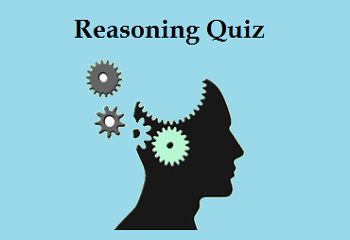Hello Aspirants. Welcome to Online Quantitative Aptitude Section in AffairsCloud.com. Here we are creating sample questions in Inequalities which is common for all the competitive exams. We have included Some questions that are repeatedly asked in bank exams !!!
- The respective ratio between the present age of Mohan and David is 5:x. Mohan is 9 years younger than Preethi. Preethi’s age after 9 years will be 33 years. The difference between David’s and Mohan’s age is same as the present age of Preethi.
Quantity I: Mohan’s present age
Quantity II: The value of x
A. Quantity I > Quantity II
B. Quantity I < Quantity II
C. Quantity I ≥ Quantity II
D. Quantity I ≤ Quantity II
E. Quantity I = Quantity II or relation cannot be establishedA. Quantity I > Quantity II
Explanation:
Preethi’s age after 9 years = 33 years
Preethi’s present age = 33 – 9 = 24 years
Mohan’s present age = 24 – 9 = 15 years
David’s present age = 15 + 24 = 39 years
Ratio between Mohan and David = 15 : 39 = 5 : 13
X = 13 - Sri invested some amount(x) at the rate of 12% simple interest and a certain amount(y) at the rate of 10% simple interest. He received yearly interest of Rs.140. But if he had interchanged the amounts invested, he would have received Rs.4 more as interest.
Quantity I: The value of x
Quantity II: The value of y
A. Quantity I > Quantity II
B. Quantity I < Quantity II
C. Quantity I ≥ Quantity II
D. Quantity I ≤ Quantity II
E. Quantity I = Quantity II or relation cannot be establishedB. Quantity I < Quantity II
Explanation:
Amount invested at 12% = Rs. x
Amount invested at 10% = Rs. y
140 = x*12*1/100 + y*10*1/100
12x + 10y = 14000 -(i)
144 = x*10*1/100 + y*12*1/100
10x + 12y = 14400 -(ii)
x = 545.45; y = 745.45 - Ajith can do a piece of work in 10 days, Bala in 15 days. They work together for 5 days, the rest of the work is finished by Chand in two more days. They get Rs. 6000 as wages for the whole work.
Quantity I: What is the sum of Rs.100 and the daily wage of Bala?
Quantity II: What is the daily wage of Chand?
A. Quantity I > Quantity II
B. Quantity I < Quantity II
C. Quantity I ≥ Quantity II
D. Quantity I ≤ Quantity II
E. Quantity I = Quantity II or relation cannot be establishedE. Quantity I = Quantity II or relation cannot be established
Explanation:
Ajith’s 5 days work = 50%
Bala’s 5 days work = 33.33%
Chand’s 2 days work = 16.66%[100- (50+33.33)]
Ratio of contribution of work of Ajith, Bala and Chand = 3 : 2 : 1
Ajith’s total share = Rs. 3000
Bala’s total share = Rs. 2000
Chand’s total share = Rs. 1000
Ajith’s one day’s earning = Rs.600
Bala’s one day’s earning = Rs.400
Chand’s one day’s earning = Rs.500 - A Bike is available at 40% discount at showroom “A” and the same is available at only 25% discount at showroom “B”. Mr. Arun has just sufficient amount of Rs. 60,000 to purchase it at showroom “A”.
Quantity I: Difference between Marked Price and SP at Show Room “A”
Quantity II: Difference between Marked Price and SP at Show Room “B”
A. Quantity I > Quantity II
B. Quantity I < Quantity II
C. Quantity I ≥ Quantity II
D. Quantity I ≤ Quantity II
E. Quantity I = Quantity II or relation cannot be establishedA. Quantity I > Quantity II
Explanation:
Let the marked price be x.
Cost price (CP) = 40 % discount on MP = 0.6y = 60000
⇒ y= Rs.100000 MP
SP at Show Room “A” = Rs. 60000
SP at Show Room “B” = 100000 X 0.75 = 75000
Difference between Marked Price and SP at Show Room “A” = 40000
Difference between Marked Price and SP at Show Room “B” = 25000 - Quantity I: (x – 18)² = 0
Quantity II: y² = 324
A. Quantity I > Quantity II
B. Quantity I < Quantity II
C. Quantity I ≥ Quantity II
D. Quantity I ≤ Quantity II
E. Quantity I = Quantity II or relation cannot be establishedC. Quantity I ≥ Quantity II
Explanation:
x² – 36x + 324 = 0
x = 18, 18
y² = 324
y = ±18 - A Cistern has an inlet pipe and outlet pipe. The inlet pipe fills the cistern completely in 1 hour 20 minutes when the outlet pipe is plugged. The outlet pipe empties the tank completely in 4 hours when the inlet pipe is plugged.
Quantity I: Inlet pipe Efficiency
Quantity II: 3 times of Outlet pipe Efficiency
A. Quantity I > Quantity II
B. Quantity I < Quantity II
C. Quantity I ≥ Quantity II
D. Quantity I ≤ Quantity II
E. Quantity I = Quantity II or relation cannot be establishedE. Quantity I = Quantity II or relation cannot be established
Explanation:
Inlet pipe Efficiency = 100/(8/6) = 75%
Outlet pipe Efficiency = 100/(4) = 25%
3 times of Outlet pipe Efficiency = 75% - Harish took an educational loan from a nationalized bank for his 2 years course of MBA. He took the loan of Rs.5 lakh such that he would be charged at 7% p.a. at CI during his course and at 9% CI after the completion of the course. He returned half of the amount which he had to be paid on the completion of his studies and remaining after 2 years.
Quantity I: He returned half of the amount which he had to be paid on the completion of his studies
Quantity II: He returned remaining amount after 2 years
A. Quantity I > Quantity II
B. Quantity I < Quantity II
C. Quantity I ≥ Quantity II
D. Quantity I ≤ Quantity II
E. Quantity I = Quantity II or relation cannot be establishedB. Quantity I < Quantity II
Explanation:
5,00,000 * (1.07)² = 572450
Returned amount = 286225
After two years = 286225 * (1.09)² = 340063 - The average salary of the entire staff in an office is Rs 250 per month. The average salary of officers is Rs 520 and that of non-officers is Rs. 200.
Quantity I: Number of Officers = 15
Quantity II: Number of Non-Officers
A. Quantity I > Quantity II
B. Quantity I < Quantity II
C. Quantity I ≥ Quantity II
D. Quantity I ≤ Quantity II
E. Quantity I = Quantity II or relation cannot be establishedB. Quantity I < Quantity II
Explanation:
Let the required number of non–officers = x
200x + 520 x 15 = 250 ( 15 + x )
250x – 200x = 520 * 15 – 250 x 15
50x = 4050
x = 81 - The perimeter of a rectangle and a square is 160 cm each. If the difference between their areas is 600 cm.
Quantity I: Area of Square
Quantity II:Area of Rectangle
A. Quantity I > Quantity II
B. Quantity I < Quantity II
C. Quantity I ≥ Quantity II
D. Quantity I ≤ Quantity II
E. Quantity I = Quantity II or relation cannot be establishedA. Quantity I > Quantity II
Explanation:
Perimeter of rectangle = Perimeter of Square = 160
4a = 160 => a = 40
Area of square = 1600
1600 – lb = 600
lb = 1000 cm² - Shree started traveling from a place A to B and Priya started traveling from a place B to A which are 576 km apart. They meet after 12 hours. After their meeting, Shree increased her speed by 2 km/hr and Priya reduced her speed by 2 km/hr, they arrived at B and A respectively at the same time.
Quantity I: Initial Speed of Shree
Quantity II: Initial Speed of Priya
A. Quantity I > Quantity II
B. Quantity I < Quantity II
C. Quantity I ≥ Quantity II
D. Quantity I ≤ Quantity II
E. Quantity I = Quantity II or relation cannot be establishedB. Quantity I < Quantity II
Explanation:
Sum of their speeds = Distance/time = 576/12 = 48 kmph
Respective Speed of Shree and Priya = (23 + 25) = 48 kmph
AffairsCloud Recommends Oliveboard Mock Test
AffairsCloud Ebook - Support Us to Grow
Govt Jobs by Category
Bank Jobs Notification



